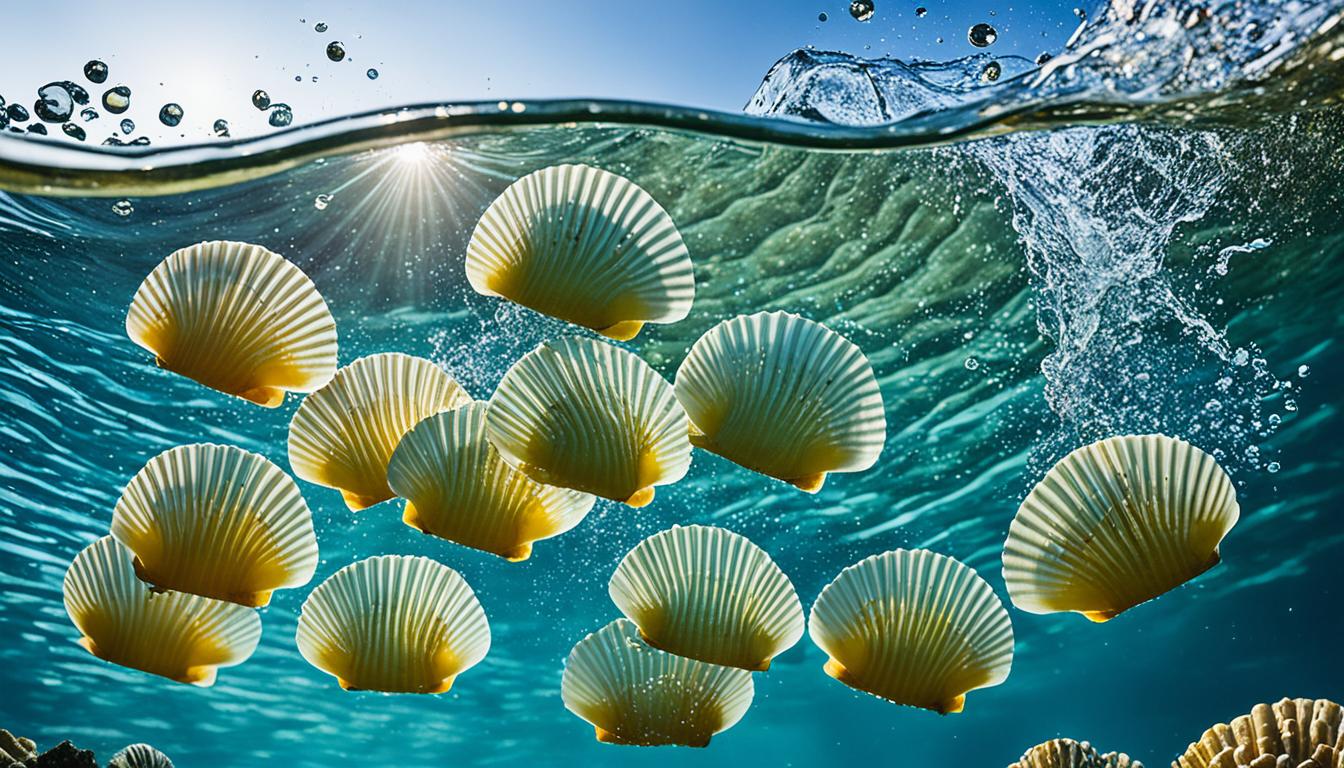Scallops are fascinating creatures that move in unique ways, unlike many other bivalves. They have special techniques to avoid predators and find food. This article will explore how scallops swim and the amazing features that help them move.
We will look into how scallops move, their anatomy, and their strategies to survive in different places. Let’s dive into the world of scallop mobility together.
Understanding Scallop Locomotion
Scallops have a unique way of moving that’s different from other bivalves. They use a special swimming method to move around. This helps them avoid predators and explore their world.
The Unique Swimming Mechanism
Scallops move by quickly clapping their hinged shells together. This creates a jet of water that lets them swim short distances. Their shell design is key to this special way of swimming, unlike other bivalves that stay still.
Jet Propulsion Explained
Jet propulsion is key to how scallops move. They use their muscles to close the shell fast, pushing water out. This movement is similar to how squids move, showing how scallops have evolved to be more active.
Comparison with Other Bivalves
Scallops are unique among bivalves for their ability to move around. Most bivalves, like clams, don’t move much. They use burrowing or pedaling to get around. Scallops, with their special swimming and jet propulsion, can move more freely in the water.
How do scallops move?
Scallops move in a fascinating way, showing off nature’s engineering skills. They use valve movement and muscle contraction for their speed. When they want to move, they use their adductor muscles to open and close their shell valves.
Valve Movement and Muscle Contraction
Scallops start by opening their valves to suck in water, creating a vacuum. This starts their movement process. Then, they quickly close their valves by contracting their adductor muscles. This quick action helps them move through the water.
Rapid Closure and Water Ejection
When the valves close fast, it pushes water out through openings near the hinge. This creates a force that helps them swim quickly. Scallops can move up to 37 cm per second using this method. Their ability to move shows how well they’ve adapted to life in the water.
Scallop Swimming Behavior
Scallops are amazing at moving through the water, especially when they sense danger. They know how to swim away from threats to stay alive. Their swimming skills are key to their survival.
Responses to Predators
When scallops see danger, they move fast and agilely. They use a special way of swimming called jet propulsion to quickly get away from fish or starfish. This quick move helps them avoid being caught by predators.
Short-Distance Swimming Techniques
Scallops also have ways to swim short distances effectively. They make quick, controlled movements to dodge obstacles and avoid capture. This requires precise muscle control to manage their buoyancy and direction. The way they move their muscles and valves is truly impressive.

Anatomy Involved in Scallop Movement
Scallops have a special anatomy that helps them move through the water. Their body structure and muscles work together to make them swim and close their shells well.
The Role of the Adductor Muscles
Scallops have two types of adductor muscles: fast-twitch and slow-twitch. The fast ones help them swim fast to get away from predators. The slow ones help them close their shells for a long time, saving energy when they’re not moving.
This shows how scallops can adapt to their underwater world.
Structure and Function of Scallop Shells
The scallop shell is made of two parts that connect with a strong ligament. This lets scallops open and close their shells easily. This is important for swimming and staying safe from danger.
The design of the shell shows how scallop movement is key to their survival in different places under the sea.
| Adductor Muscle Type | Function | Energy Efficiency |
|---|---|---|
| Fast-twitch (Striated) | Rapid swimming and quick responses | Less energy efficient, quick bursts of activity |
| Slow-twitch (Smooth) | Prolonged shell closure and energy conservation | More energy efficient for long durations |
Environmental Impact on Scallop Movement
Scallops move through their aquatic homes in ways shaped by their environment. They live in places like sandy bottoms and rocky reefs. Water currents and temperature greatly affect their swimming and finding food.
Predators also change how scallops move. When threatened, scallops change their swimming ways based on their surroundings. This helps them survive and shows how important they are in their ecosystems.
Looking into how scallops move tells us about their adaptability. This is key to understanding their role in the ocean. By studying their movements, we learn more about marine life and how to protect it.
FAQ
How do scallops move?
Scallops move by quickly clapping their shells together. This action creates a jet of water that pushes them forward. This method helps them avoid predators and explore their surroundings.
What is scallop locomotion?
Scallop locomotion is how scallops swim using their valves and adductor muscles. They open their shells to take in water and then close them fast. This action pushes the water out, making them move forward.
Can scallops swim long distances?
Scallops can swim, but they usually do so in short bursts. They mainly swim to get away from predators. Long-distance swimming is more common in other sea creatures.
How fast can scallops swim?
Scallops can swim up to 37 cm per second. They use their jet propulsion method to move quickly when they close their valves fast.
What role do the adductor muscles play in scallop movement?
The adductor muscles are key for scallop movement. They help scallops swim in short bursts and stay closed for a while. This muscle coordination helps them escape predators and move through the water.
How do scallops react to predators?
When scallops feel threatened, they swim away quickly using their shell-clapping motion. This unpredictable swimming helps them avoid predators like starfish.
What anatomical features assist scallops in their movement?
Scallops have a special shell and adductor muscles that help them move. Their shells have two parts connected by a strong ligament. This structure is important for swimming and protection.
How do environmental factors influence scallop movement?
Things like water currents, temperature, and predators affect scallop movement. These factors change how they swim and find food in different water environments.







